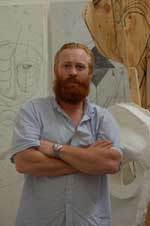It is not always that I remember when I first saw an artist’s work but in the case of Thomas I do remember. It was in 2006 at LA Artists from the Rubell Family Collection one of the Rubell Collection openings. It was Art Basel Miami week when arted out from the fair I came into a room composed of several large menacing, seemingly primitive figures. Coarse plaster figures, the faces were roughly drawn smudgy charcoal masks recalling the primitive faces from Picasso’s Demoiselles d”Avignon their wrenched apart. My reaction walking among them was of encroaching in someone else’s territory. It was a place seemingly dangerous to enter but somehow worthy of exploration.
I was impressed by the work enough to seek Houseago out when I next went to Los Angeles. Gary Garrell, then at the Hammer, sent me to his studio in East LA and I spent a few hours with the red haired guy born in 1972 in Leeds who arrived in LA via studying in Holland . Lured by his friendship with fellow artist to this part of East LA which the Standard where I was staying warned me from entering.
I liked his red haired palpable high- energy. He told me he was married to an Italian woman and loved spending time in Florence studying Michelangelo. How much his work related to the old masters and how much he owed to their influence. There is also palpably a thread of European modernism in the work from Rodin and Picasso through to England’s own Jacob Epstein. He was impressive, fierce and committed. At the time there was little in the studio as he told me he was between bouts of work. He worked in two small rooms, building the plaster works on the floor face down so when he broke them loose he really did not always know what they would look like. There was an element of risk that he liked. He admitted that there was little work as recently he had sold a group of works to a hedge fund collector, Steven Cohen. He was cleaning out and thinking about the next group.
After that my only contact with him was seeing his work at art fairs around the world. His galleries grew in numbers and it was only when I stumbled on a large bronze on a Belguim gallery stand at Basel last year that I began to begin to question the quantity of his output. ‘Why bronze?’, I asked pointing at a rather glunky looking seated figure – ‘collectors wanted them for outside so they needed to be in different materials’. Oops I thought. Here is an artist who was all about transient materials, often found he had told me in skips in LA that he lugged back to the studio to await their moment . He had related when a collector returned a work to be repaired as a cigarette pack had fallen out of it. ‘Yes, I used whatever materials to make the plaster with that was handy. I just restuffed it into the sculpture’.
Now Thomas has a show at Oxford MOMA. I went to see it on a cold winter’s day. The day before I had lunch with a young artist who said dismissively , ‘oh Houseago! You see them all over art fairs in the way you used to see Oursler’s everywhere or Reyles.
The first omens were not good. The main large room has one early work, the only early work in the show. Crouching Figure from 1998. There is something deeply wrong about this work but it is this wrongness that is right. Ominous, awkward, hands cut off at the wrists, getting close to it one feels that you are crowding a primeval form, pulsating with raw energy.
Nearby there is a pile of clay, transformed into gilded bronze, looking strange and not very interesting. Standing with Michael Stanley, the director points to the Clay Mountain 1 (Sun) nearby, signs of an artist imprinted clearly. This is like a work I had seen in LA. Mounded on the floor, full of marks and incident and experimentation and alive. Nearby a work, Biggest Spoon-outdoors (2010) lies on the floor, inert and boring. So it is a big spoon, so what? This work is worlds apart from Crouching Figure nearby. An artist intent on making works that can adorn collectors gardens.
It is not all bad here. An impressive recent work, Baby stands alone in a nearby gallery. Split apart showing the different methods of work that Hoseago has mastered. Twirls of clay around the arms, braced with raw metal, split apart. Drawn on. Worked on. Exciting.
We go to lunch at the Ashmoleon, guarding the stairs a Houseago sentinel, white bronze masquerading aa plaster its feet on the base awful awkward snowshoes to balance the stonking bronze weight. Ugh. The jury is out - Thomas.





No comments:
Post a Comment